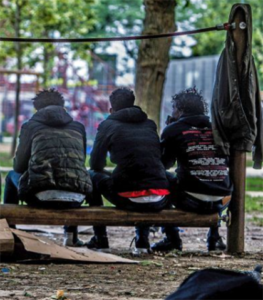Europe grappling with rising numbers of failed asylum seekers
Hundreds of thousands of migrants across the European Union are being rejected in their bids for protection creating a new crisis because tricky logistical and political reasons mean few are being sent home.
 As the cases crawl through Europe’s court systems, a new kind of migration challenge is emerging – one focuses not on arrivals but on people who have been rejected by the protection systems.
As the cases crawl through Europe’s court systems, a new kind of migration challenge is emerging – one focuses not on arrivals but on people who have been rejected by the protection systems.
Overwhelmingly, most rejected migrants fall into a legal limbo in which they have no right to support, housing or work permits, and little opportunity to go elsewhere.
The only option for many is to stay and somehow get by.
An uproar recently emerged in Scotland where hundreds of failed asylum seekers where due to be evicted from public housing and thrown on to the street by multinational service provider Serco. An eleventh-hour court action has halted the evictions for now.
The issue particularly noticeable in Italy, where a right-wing, law-and-order focused government has worked to reduce the odds that migrants win protection — while meantime falling short of its pledges to increase deportations.
Italy’s far-right interior minister, Matteo Salvini, last year warned undocumented migrants to get ready to “pack their bags,” and he vowed to send home 100,000 people during his government’s first year.
Instead, facing off against countries that are resistant to accepting returnees, Italy deported fewer than 7,000.
Undocumented migrants often end up in Italy’s agricultural south, working in exploitative circumstances in tomato fields.
Much of Italy’s agricultural exports are underpinned by the exploitation and coercion of migrant labourers as well as inhuman working and living conditions.
According to the Observatory Placido Rizzotto, an organisation which investigates working conditions in Italian farming, there up to 500,000 migrant workers in Italy’s agricultural sector, around half of its total workforce.
And the Observatory says 80 per cent of these have no work contracts, a situation that has been exploited by Italian farmers since the 1970s, when migrants first started to arrive.
Migrants also work in the black economy in construction or they sell trinkets to tourists in the major cities.
Many rejected migrants have lost their homes and live in rickety squatters’ camps.
The European Union has estimated that more than a million people will ultimately
European heads of government agreed last year that regular deportations send “a strong signal against undertaking dangerous irregular journeys to the EU in the first place.”
In June, Germany, which has rejected more than 400,000 asylum seekers over the past five years, passed a new law aimed at what its interior minister called “faster, more efficient” deportations.
Programs for the few undocumented migrants who want to return voluntarily have focused primarily on people from Iraq, the Balkans and former Soviet nations.
Syrians, who in Europe win protection more than 95 percent of the time, account for one-quarter of the 4 million people who have sought asylum across the continent since 2014, when migration levels first spiked; but they are largely pursuing those cases in northern European countries.
The migrants who have applied for asylum in Italy are more typically from Senegal, Bangladesh, Gambia and Nigeria — people fleeing climate change, domestic violence, terrorism or deep poverty.
Estimates say Italy’s undocumented population will increase by 90,000 by the end of 2020, reaching an estimated total of more than 700,000 — even though the country has all but closed its doors to new arrivals.
Over the past five years, Italy has deported 19 percent of foreigners given orders to leave, according to European data
The majority of the deportees are from three countries: Albania, Tunisia and Morocco.
For most sub-Saharan African countries, the deportation rate is below 10 percent. For those from Bangladesh it is 7 percent.












